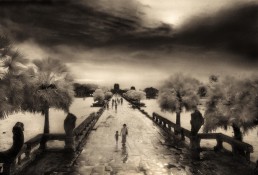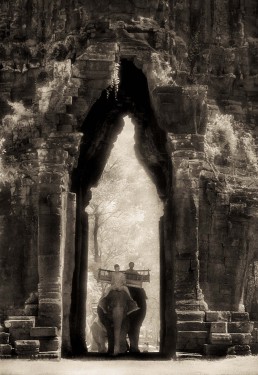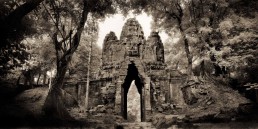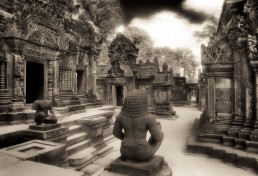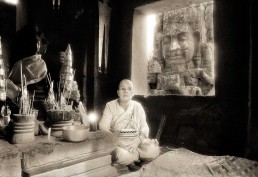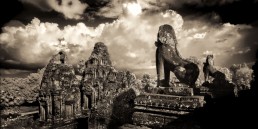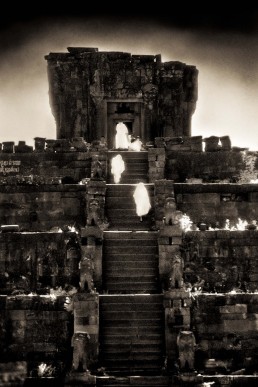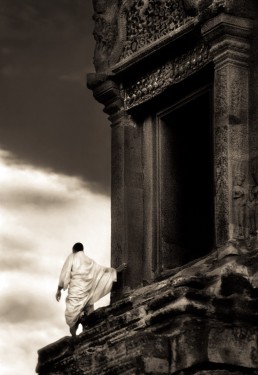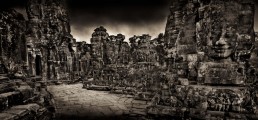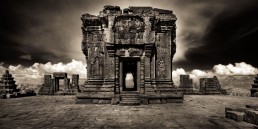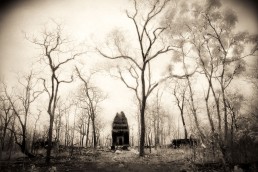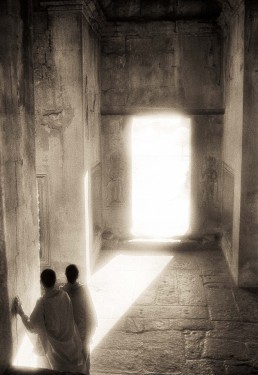Photographer John McDermott explains the background to his most striking images of Angkor.
ABOVE: SOLAR ECLIPSE — ANGKOR WAT, 1995
“This is the picture that started it all for me: the total solar eclipse of October 1995. It was a beautiful, sunny day and there were maybe 1,000 or so people at Angkor Wat. I shot on three or four different types of film that day, and I had one camera loaded with infrared film. I wanted to see how the eclipse — and the different type of light — would affect the film. I set up on the right side of the causeway, where there were fewer people.
“It was my first time to witness an eclipse. As the moon passes in front of the sun, colour diminishes and everything becomes monochromatic. Just a few seconds before totality hits, the light flutters, and then you are plunged into darkness, with just a thin strip of light around the perimeter of the horizon.
“This picture was taken about a minute before totality, and when I saw the result I thought it had really captured the mood and feeling of the moment. The image I made right after this — when we were in full totality — was rendered dark. I’d never before witnessed anything of such magnitude as an eclipse and I was deeply moved. It brought tears to my eyes.”
CAUSEWAY AFTER A RAINSTORM — ANGKOR WAT, 2000
“One of the criteria I had for this series was having no indicators of time in my shots. There’s nothing in the frame — except perhaps the woman’s handbag — that indicates modernity; there are no bicycles, no baseball caps. I was looking back towards the entrance and the causeway, with Angkor Wat right behind me.
“It had just rained — that spring rain that pours real hard and then ends quickly — and the sun had just broken through the clouds, so there was fantastic light. The causeway was glowing, providing the perfect backdrop for something to happen. So I sat down and waited for my subject to come along, and a few minutes later, there it was: a local woman leading a young boy to the temple, and the perfect poetic moment.”
ELEPHANTS AT THE GATE — SOUTH GATE OF ANGKOR THOM, 2000
“This is one of my most popular images, taken the first time I’d seen elephants at the temples. It was early afternoon when they lumbered through the South Gate, but I missed the shot, so I grabbed one of the mahouts and asked when they’d return. He said at about 4pm, so I waited and prepared, positioning myself quite far away, using a long lens to condense the distance.
“There were a few tourists milling around, however, and when the elephants came back and I began shooting, one guy stood right in front of me. I was so afraid I was going to miss the shot, but he moved slightly out of frame, and I managed to capture the moment as the animals came through the gate.
“The howdahs were tilted just right, so you can see both of the men riding the elephants. The picture also highlights the immensity of the gate, which was actually built to handle elephant caravans.”
THE WEST GATE — ANGKOR THOM, 2008
“This is one of my personal favourites. I’d bought a new film camera that shoots in a panoramic 2×1 format, and I’d taken it out to try, having fun shooting here and there. Hardly anyone ever visits the West Gate, and it had become my personal place of refuge. It was really out in the forest down a dirt road, with a simple pathway that local people used to get to their villages. It reminded me of a setting in a fairy tale, where it might have been the entrance to something sinister.
“I photographed the gate several times, finally getting the shot I wanted. I went back to the gate a couple of months later, and a wooden ramp had been built through its centre, so that traffic could pass, and now it has huge wooden bracing on the outside. Visually, this scene can no longer be found, like so many in my portfolio.”
TWISTED TREE — TA PROHM, 2001
“I shot this image for the New York Times, which ran it large to illustrate a story about the trees of Angkor. The image has a painterly quality, partially due to the graininess of the infrared film, but also because of the light coming through the trees. This tree also had a real strong character, like something from a scary children’s story of old.
“The dappling of light and shadow gives an impressionistic feel. As a ‘pictorialist’ photographer, I’m going for mood, for an emotional response, rather than recording reality with precise technical perfection. That’s what is most important to me.”
THE COURTYARD — BANTEAY SREI, 2000
“This was shot when few people visited Banteay Srei, when you could wander freely. These days the central area is roped off and you can’t get up close to the carvings, which ultimately is a good thing because they were being damaged. These guys — these monkeys — are now gone.
“At the time I took the picture, they were all headless or faceless due to looting, and since then the authorities have taken the original statues away and replaced them with replicas. They’ll weather in time, but for me there’s a lack of purity in that. I accept the need for preservation, but I want to see the real thing that’s been sitting there for 1,000 years. The originals are now stored at a conservation centre here in Siem Reap and in the museum in Phnom Penh.”
THE FACE IN THE WINDOW — THE BAYON, 2000
“This lady was at the Bayon for years. It seemed like every time I went there, I’d pass by this little shrine — a small chamber up on the terrace — and she’d be sitting inside, handing out incense for 1,000 Riel or so. I don’t see her anymore, and wonder what happened to her.
“Capturing the stone face through the window has been done many times by photographers, but I still take pride in this portrait. It uses only natural light, and I’ve managed to pull the woman’s face out of the darkness (it was very gloomy in the chamber). There are some pleasing textures at work here, too: the stonework, the straw mat … and I like the visual echo of two Khmer faces.”
TEMPLE LIONS IN CLOUDS — PRE RUP, 2008
“Pre Rup has always been a magical place for me, for reasons I don’t truly understand. There’s just something about the place — it speaks to me. Anyway, Pre Rup has these really attractive temple lions, and I’d been walking around the structure, trying to find a rewarding vantage point. It was one of those idyllic days with magnificent clouds and skies.
“This shot works because of the clouds, in fact. I’ll be the first to admit that dramatic cloud formations play major roles in many of my Angkor compositions.”
MONKS ASCENDING THE STAIRCASE — PHNOM BAKHENG, 2001
“This was taken at the end of a day’s shooting. I was finishing up the day at Phnom Bakheng, and there was nothing much happening. I was about to head home when I spotted a group of monks coming up the pathway, and I knew they were going to look wonderful against the stone.
“Orange robes glow white in infrared, and the light spreads a little on the film, creating a halo effect around the monks’ bodies and giving them a mystical, ethereal appearance.”
MONK IN THE WIND — ANGKOR WAT, 2001
“This monk in the wind was one of those photographic ‘decisive moments’, as the late Henri Cartier-Bresson called them.
“In the old days you could go to the highest levels of Angkor Wat and walk around, sit on the steps at the very top, enjoy some solitude and watch the sunset. I was down a level on this occasion, looking up, and the monk stepped out to take in the view. I got a couple of frames and he was gone. I’d love to be able to go up there again, just to sit down and get away from the crowds.”
MAIN TERRACE — THE BAYON, 2008
“Shooting the Bayon without the hordes has long been a challenge, and by 2008 it was very difficult, but I waited until late in the afternoon, stood my ground, moved some signage out of the way, and only had a few seconds to capture this image without anyone walking through.
“I had to work really hard in the darkroom with this shot, to bring the tones down, and to darken the clouds at the top and shade the bottom, leading the eye down the pathway and into the drama. All of my images are worked very hard in the darkroom as the negatives are not very pretty, or easy to work with. I have to push them hard to get the drama out of the scenes I want.”
UPPER TERRACE — PHNOM BAKHENG, 2008
“Nobody really goes to Phnom Bakheng except at sunset, but I was up there one morning. Here again, we benefit from perfect clouds. That low row of wispy clouds, in fact, really sets off the subject, giving the impression of a mysterious temple in the heavens. And again, this photograph was taken with that 2×1 panoramic camera, and that format is fundamental to the image’s power. The central structure makes an ‘I am here’ statement, and there’s a real, solid sense of presence.
“This print hangs in the entrance to the United States Embassy in Phnom Penh. I’m very flattered by that. Many of these prints are also part of the permanent exhibition in the National Museum in Phnom Penh.”
THE BLACK LADY — PRASAT NEANG KHMAU, 2005
“There are several little temples at Koh Ker, which is way out from Angkor Wat and miles off the main tourist circuit, and I took a drive out there in 2005. They call this structure the Black Lady because the stone looks as if it has been charred. It was constructed from a certain type of sandstone that has weathered that way, giving a faint sense of foreboding.
“The authorities were de-mining the area at the time, and so all the surrounding vegetation had been burned off, giving the scene an apocalyptic quality. This photograph is the antithesis of most of my Angkor work, but there’s a soul to it that I really like.”
MONKS IN SUNLIT DOORWAY — ANGKOR WAT, 2000
“This is another of my favourite shots. Angkor Wat faces west, so sunlight — if it’s a bright day — blasts through windows and doors in the late afternoon. The light is truly beautiful as it streams inside. I took a number of agreeable shots while walking along the entire frontage of Angkor, and this is perhaps the best.
“I came around a corner and there it was: an ideal setting waiting for something to happen. I just needed that something — a subject for my shot — another ‘decisive moment’. Soon, two monks pushed by me and stopped to pause and look through the doorway before continuing on their way. Everything had fallen into place. I was barely able to get one perfect frame before they were gone forever.” ◉
SHARE


